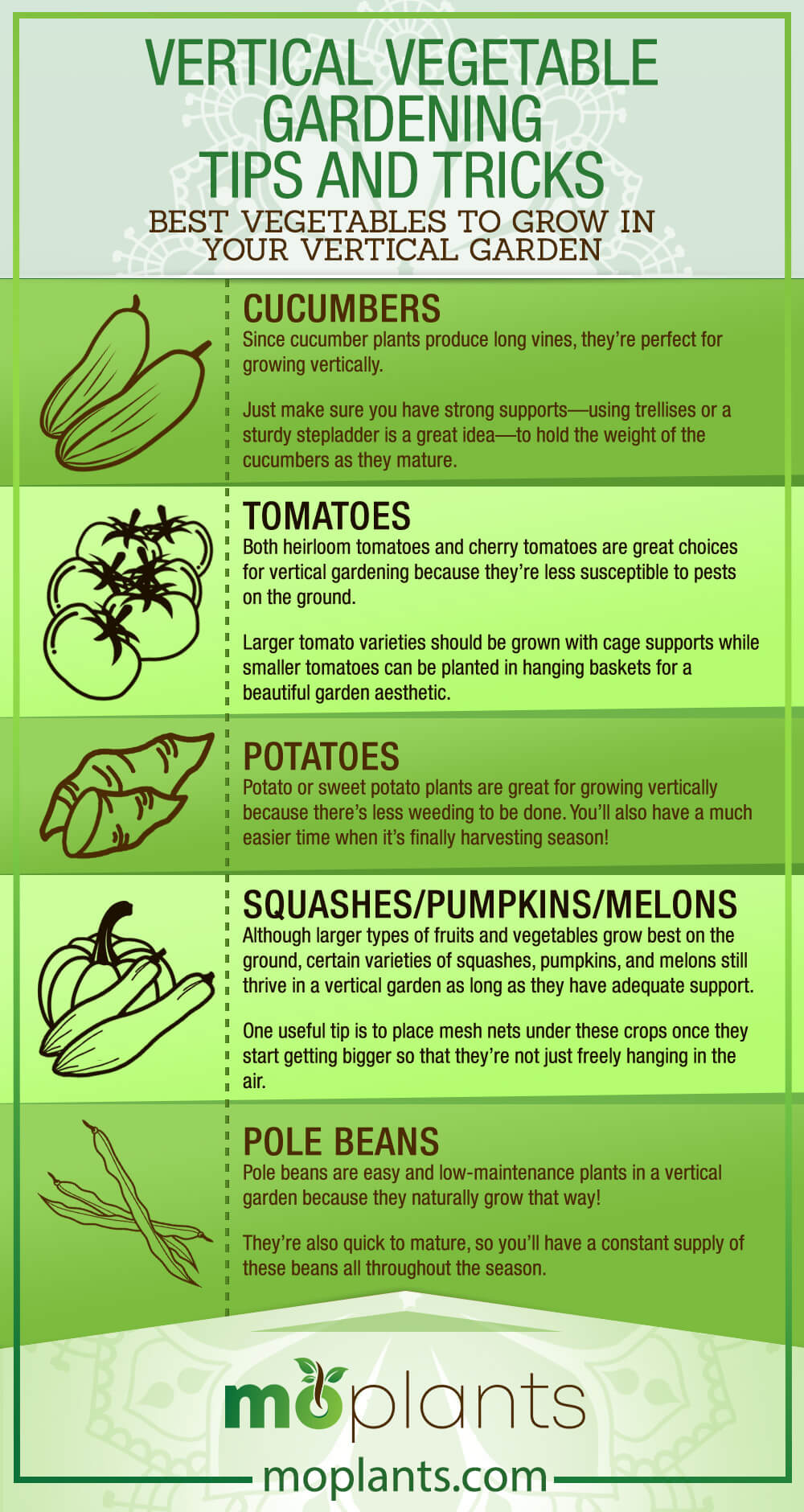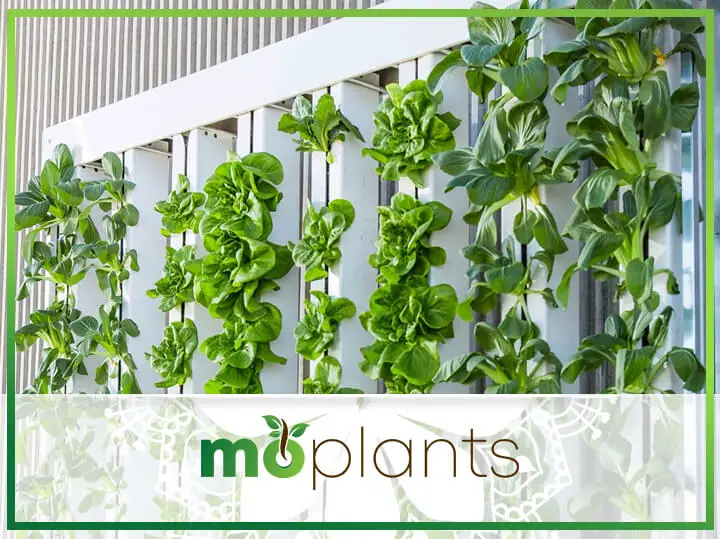If you live in the city, chances are, you don’t have much outdoor space for a full vegetable garden.
However, this doesn’t mean that you have to give up gardening altogether.
In fact, you should consider setting up a vertical vegetable garden to save space and get a fresh supply of veggies/food all year round!
If this sounds good to you, read on for our tips on how to start your own one at home.
Building Your Vertical Vegetable Garden
Almost anything can be used as structures for your vertical vegetable garden.
Plants can wrap their vines around any existing wood or chain-link fence, or you can opt to purchase trellises, arbors, stacked containers, and hanging baskets.
Here are some creative ones used by gardeners:
Stacked Crates
Because the crates are stacked in different levels, you can mix up the vegetables you plant in each space. Put shade-loving plants in the lower levels and heat-loving vegetable plants in the upper ones.
Garden Wall
This vertical wall is a design element, a privacy screen, and a vegetable garden all in one!
Usually, the support is made of hex wire attached to two sturdy posts. Simply hang terracotta pots from it and plant all your favorite herbs and veggies inside.
We love that this setup boosts air circulation in your garden too!
Hanging Baskets
While you can go for individual hanging baskets, a great way to save space is to make tiered ones.
Just thread some rope through your baskets and hang them up with a pair of strong and sturdy hooks.
Remember to leave adequate space between the hanging baskets as the plants will grow taller over time!
Repurposed/Leaning Ladder
If you have any old or unused ladders lying around, you can convert them into vertical gardens!
Arrange your pots the way you like them on the different steps. If your ladder doesn’t have a base, you can prop it up on a wall so it still stands.
Since you’re not planting directly on the structure, you can easily change the crops you’re growing depending on your needs, preferences, and mood.
Fabric Pockets
Do you have a fabric pocket organizer at home? You can actually turn this into a vertical vegetable garden! Just fill each pocket with soil and put your crops in.
The porous fabric material acts as natural drainage holes to prevent root rot, so it’s even easier to take care of your plants.
DIY Pallet Vegetable Garden
If you’re up for the challenge, you can even make your own support using wood and some common construction tools. Here’s how to do it:
Materials Needed
- Wooden pallet
- Staple gun
- Staples
- Hammer
- Nails
- Landscaping fabric
- Sandpaper
- Fiberboard
Steps
- Sand down the wooden pallet until all the faces and corners are smooth.
- Nail the fiberboard to the back of the pallet using a hammer. This will cover up the holes and prevent the soil from spilling out.
- Use your staple gun to cover the sides, back, and bottom of the structure with landscaping fabric. This material helps retain soil moisture and prevents weeds from sprouting.
- Now you’re ready to fill your DIY support with potting soil and start planting! Make sure to leave it flat for around 2 weeks (so your plants grow strong roots) before moving it upright in your garden.
Best Vegetables to Grow in Your Vertical Garden
Now that you have your vertical space ready, it’s time to start growing vertically!
Although gardening experts may be a lot more experimental with the types of vegetables they grow, we’d recommend starting with these tried and tested plants:
Cucumbers
Since cucumber plants produce long vines, they’re perfect for growing vertically.
Just make sure you have strong supports—using trellises or a sturdy stepladder is a great idea—to hold the weight of the cucumbers as they mature.
Once cucumbers are about the length of your finger, you can start picking them off the vine to eat fresh with salad greens or to pickle for future use.
Tomatoes
Both heirloom tomatoes and cherry tomatoes are great choices for vertical gardening because they’re less susceptible to pests on the ground.
Larger tomato varieties should be grown with cage supports while smaller tomatoes can be planted in hanging baskets for a beautiful garden aesthetic.
Potatoes
Did you know that you can plant potatoes in containers too?
Potato or sweet potato plants are great for growing vertically because there’s less weeding to be done. You’ll also have a much easier time when it’s finally harvesting season!
Squashes/Pumpkins/Melons
Although larger types of fruits and vegetables grow best on the ground, certain varieties of squashes, pumpkins, and melons still thrive in a vertical garden as long as they have adequate support.
One useful tip is to place mesh nets under these crops once they start getting bigger so that they’re not just freely hanging in the air.
Pole Beans
Pole beans are easy and low-maintenance plants in a vertical garden because they naturally grow that way!
They’re also quick to mature, so you’ll have a constant supply of these beans all throughout the season.
One important reminder, though: Don’t mistake bush beans for pole beans, as these won’t be suitable for a vertical garden system.
Infographic

Caring for Your Vertical Vegetable Garden
To be successful at gardening, you have to be patient and hardworking.
After all, growing vegetables takes a lot of time and effort, but trust us when we say the results will be well worth it! If you need more gardening ideas and tips, read our list below.
Choose Your Vegetables Wisely
Before buying a bunch of crops, planters, and containers for your veggie garden, be honest about how much space you’re working with.
Although vertical gardens are very compact, some vegetables grow larger than others, so they may be a nuisance when fully mature.
You should also check to see if the vegetables you want to plant thrive in your living conditions.
For instance, if your outdoor balcony doesn’t receive a lot of sun exposure, heat-loving plants will be a lot trickier to care for.
Just so you know, most vegetables flourish in full sun, but some leafy vegetables like lettuce are good in shady areas. Make the right choices for gardening success!
Have Strong and Sturdy Supports
The thing about growing vertically is that plants need a lot of support; otherwise, they could be blown away by wind or rain.
With that said, make sure you purchase (or make) sturdy structures to house your crops.
Don’t just stick the frame into the soil; it’s better to screw or nail your supports to the containers for extra stability.
Prepare Your Containers
If you’re using containers for gardening, keep these tips in mind: Have a good drainage system and fill them with a good quality potting mix.
To ensure the plants’ roots don’t rot, make plenty of holes at the bottom of your container to let out the dirty water.
You can also put a layer of crushed gravel inside before adding your soil for more drainage.
Use Nutrient-Dense Soil
Gardeners often use a mix of topsoil, compost, and fertilizer for the best outcome.
These organic materials provide the nutrients that the plant needs to grow quickly and robustly, so don’t belittle the importance of this component!
Encourage Vertical Growth
Although the plants in your vertical garden should naturally grow upwards, sometimes, the vines can go all over the place.
To nudge them in the right direction, try tying them to the fence or to their supports with twine.
Water Your Plants Regularly
Lastly, don’t forget to water your plants, especially when you’re not getting much rain!
Just make sure you’re not pouring in a large amount, as you could drown their roots. Always check that your drainage system is still working effectively too!
Final Thoughts
Does the image of a compact, lush, and healthy vegetable garden look great to you? You should definitely consider growing vertically.
Even if you live in a tiny apartment in the USA, you’ll still have many plant varieties to choose from; plus, you won’t have to spend a large amount to set this up either.
Now, all that’s left to do is get started. Happy gardening!


